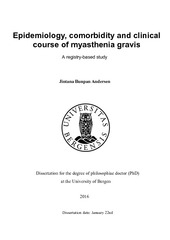| dc.contributor.author | Andersen, Jintana Bunpan | en_US |
| dc.date.accessioned | 2016-03-18T13:23:12Z | |
| dc.date.available | 2016-03-18T13:23:12Z | |
| dc.date.issued | 2016-01-22 | |
| dc.identifier.isbn | 978-82-308-3403-9 | en_US |
| dc.identifier.uri | https://hdl.handle.net/1956/11708 | |
| dc.description.abstract | Background: Autoimmune myasthenia gravis (MG) is a rare neuromuscular transmission disorder. The pathophysiologic mechanisms are well-studied, but the etiology remains unknown. The clinical course of MG is still characterized by remissions and exacerbations. Identifying prognostic factors may be helpful when choosing treatment strategies in MG patients. Studies on MG epidemiology report increasing prevalence and incidence of the disease. However, the reported data on MG epidemiology and of prognostic factors vary considerably, reflecting differences in study design, case ascertainment and measurements of clinical severity and outcome. Objectives: First, we aimed to determine the prevalence, incidence and gender specific characteristics of MG patients needing drug treatment in a well-defined population cohort. Second, we examined the total drug treatment and comorbidity in MG patients. Finally, we aimed to assess the clinical course of MG, and to identify prognostic factors that may contribute to a good outcome in MG patients. Materials & Methods: Patient information in papers I and II was retrieved from the Norwegian Prescription Database, which contains information on all prescription drugs expedited in Norway since 2004. In paper III, comprehensive clinical information on MG patients treated in a consistent fashion for over three decades was obtained from the Myasthenia Gravis Patient Database at Duke University Medical Center (North Carolina, USA). Results & Conclusions: The point prevalence of symptomatic MG in a complete Norwegian cohort 1 January, 2008 was 131 per million inhabitants, and the incidence rate for the year 2007 was16 per million. Our calculated prevalence and incidence is in agreement with other population-based studies. MG patients are more often treated with non-MG prescription drugs than patients using drugs for most other conditions, reflecting frequent comedication and medical comorbidity. The prognosis of MG is favorable for the majority of patients, regardless of age, maximum disease severity and antibody status. | en_US |
| dc.language.iso | eng | eng |
| dc.publisher | The University of Bergen | eng |
| dc.relation.haspart | Paper I: Andersen JB, Engeland A, Owe JF, Gilhus NE. Myasthenia gravis requiring pyridostigmine treatment in a national population cohort. European Journal of Neurology. 2010; 17(12): 1445-50. This article is not available in BORA. The published version is available at: <a href="http://dx.doi.org/10.1111/j.1468-1331.2010.03089.x" target="blank">10.1111/j.1468-1331.2010.03089.x</a> | en_US |
| dc.relation.haspart | Paper II: Andersen JB, Owe JF, Engeland A, Gilhus NE. Total drug treatment and comorbidity in myasthenia gravis; a population-based cohort study. European Journal of Neurology. 2014; 21(7): 948-55. The article is available at: <a href="http://hdl.handle.net/1956/8819" target="blank">http://hdl.handle.net/1956/8819</a> Paper III: Andersen JB, Gilhus NE, Sanders DB. Factors affecting outcome in myasthenia gravis. 2015; submitted. Manuscript. The article is not available in BORA. | en_US |
| dc.title | Epidemiology, comorbidity and clinical course of myasthenia gravis. A registry-based study | en_US |
| dc.type | Doctoral thesis | |
| dc.rights.holder | Copyright the author. All rights reserved. | |
| dc.subject.nsi | VDP::Medisinske Fag: 700 | en_US |
